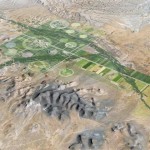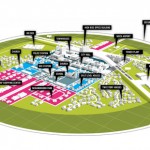CITE – Center for Innovation, Testing and Evaluation is built in New Mexico, USA, reproducing at a scale of 1/1 a whole human settlement, but without its inhabitants.
The inevitable update
The history of modern architecture is studded with juicy episodes about the dream of new ultra-technologized cities, born of utopias and technology trust; we should remember „La Città Nuova” (1914) of the Italian futurists, „Broadacre City” contoured by Frank Lloyd Wright in the ’30s, „Manhattan Bubble” (1960) of Buckminster Fuller, or „No-Stop City” (1970) brought about by Archizoom… All these were also proposing, along with a new image of urbanity, new life styles and new spatial typologies, sustained by the technical achievements. Nowadays, even if we are much less naive with respect to the hi-tech imagery, we are constantly yielding to technological pressure, verifying a permanent addiction to updates. Let’s look around us on the street: have you noticed the to-and-fro of the optical fibre cables or the expansion of the wireless networks? Well, how should we act when we have to update a whole city and its systems? How should we check the reliability of the new infrastructures? Are the small laboratories still enough when the stake of the interventions is a geographical one, or even more, a geopolitical one?
A lab-like city
The news of the construction within the following two years, in the perfect desert-like isolation of the State of New Mexico (near Hobbs, close to the frontier with the State of Texas), of the Center for Innovation, Testing and Evaluation (CITE), as a real-world scale city, wouldn’t take anyone by surprise: in the last decades, urban technologies have taken a sufficiently big step forward so as to allow a special effort in this respect. What is really surprising is something else: on the one hand, this city is not going to be inhabited, being thus a „ghost city”; on the other hand, the image of the city is not a futurist one, as we would expect, but a rather conventional one, since it is simulating a generic American city of 3,500 inhabitants, typical for the United States. Thus, super-technology seems rather invisible, scattered through the underground entrails of the settlement, or partially visible, by means of the unusual processes of traffic automation (vehicles without drivers) or the ecological production of energy and food. I remember an observation made at some point, in an interview, by the French architect Jean Nouvel, regarding the relation between hi-tech imagery in architecture and post-industrial technological progress: what is really sophisticated and advanced tends to disappear, to become invisible… Thus, CITE is not a real city, but a laboratory-like city meant for testing new technical systems for intelligent cities.
Trust and suspicion with respect to intelligent cities
Intelligent cities are gradually getting out of science fiction and materializing: we are talking about various projects that are being developed at the moment, such as Masdar City of the United Arabian Emirates, King Abdullah Economic City (KAEC) in Saudi Arabia and PlanIT Valley, in Paredes, Portugal. In contrast with these new settlements that are being gradually populated (and where the inhabitants themselves submit to the tests, as in the case of PlanIT Valley), CITE is an unpopulated urban environment, for security reasons, entirely simulated and free from legal, cultural and financial constraints that define ordinary cities, with the purpose of testing how various available urban technologies can be actually implemented and integrated without endangering the life of the inhabitants. It is true that precisely this „ghostly” aspect is feeding the suspicions regarding „the loss of control”, like in SF scenarios where robots end up taking control of the factory that is producing them and of the people who designed them, but CITE is officially promoted as a transparent environment of the open access type for the scientists, innovators and investors all over the world (supposed to be well-intentioned and responsible). Pegasus Global Holdings LLC – promoter of this project – is a well-known telecommunication leader in North America and Europe; it is also a US Government authorized manufacturer and provider of military defence equipments and technologies. In a less conspiratorial note, Pegasus offers to private inventors and innovators or public institutions authorization solutions for their projects under copyright conditions, assuming the risks of prototype production, serial production, distribution and service for potential clients. In what concerns the CITE development itself, Science Applications International Corporation (SAIC) shall lead the analysis of the various aspects of the project and shall be in charge of the entire business, design and construction.
Organization, plans and numbers
CITE, privately owned and administrated, shall take up 52 km2 and shall cost at least 200 million $. By 2014, it shall accommodate urban, suburban and agricultural areas, along with new and obsolete infrastructure networks in order to reflect the characteristic situation of the major part of USA. The testing and evaluation services for intelligent systems and the emergent ecological technologies in real-world application conditions are unique in the world and give significant opportunities to small and medium enterprises which couldn’t afford otherwise the testing costs for their own innovations. We are referring to renewable energy integration networks (solar, geothermal, etc.), Intelligent Transportation Systems, Smart Grid Technologies (intelligent networks for energy exploitation and distribution), the future generation of wireless telecommunication networks, cyber security systems and terrorism vulnerability assessment, resource development (e.g. desalination) and so on.
The City Lab
The first development layer, called „City Lab”, shall take up 160 ha and it is dedicated to the innovations in energy, telecommunications, transport, agriculture, security and constructions, which shall stimulate sustainable economical development. This is actually the “ghost” overground city with high buildings, dense or rarefied urban fronts, suburban neighbourhoods of various typologies and styles, farm areas, open extension spaces and isolated areas for special projects, an interstate road system, a wireless and fixed communication infrastructure. All the typologies of urban tissue (“Micropolitan downtown”, “Metropolitan downtown”, “Post World War II”, “Street car suburbs”, “Industrial”) can be constantly modified depending on the type of tests.
The Field Lab District
The second layer represents actually the infrastructure, a field lab district with other sublayers: the development district (International Cities, Security, Air Quality, Aging Infrastructure), the energy district (Biopower, Solar, Wind, Geothermal, Oil & Gas), the water district (Bioremediation, Spray Fields, Water Desalination) and the agriculture district (Food, Crop Production, Plant Genetics, Drought Resistance Field).
The CITE Backbone
Electromagnetic interference-proof, hidden underground, the third layer is made of an operational and maintenance system unifying the whole CITE domain and including a flexible grid for transportation of data, energy and water. One of the junctions of this data processing network shall be the control centre of the backbone. Given the mysterious nature of this network, I am sure that soon it shall become the topic of great debates on the conspiracy theory side, similar to those that have already made famous the International Airport of Denver.
The CITE Campus
Besides the great basic systems, at the entrance on the CITE site, but away from the Field Lab District (in order to avoid compromising the testing area) there shall be an interface for researchers, investors and public, made up of an overground complex of buildings for temporary accommodation and permanent living, modular labs, special rooms, production premises, conference halls, research and administration offices. In fact, this campus is the representative part for the specific imagery of the recent eco architecture, without any futurist appearance at all, at least at a first look at the preliminary renderings.
CITE Animation from zeppelin on Vimeo.
Beneficiaries and motivations
There are at least six big categories of beneficiaries of this investment: (1) laboratory financed out of federal / state funds (energy, transport, cybersecurity, intelligent systems, etc.), (2) federal / state agencies (energy, police, etc.), (3) universities and research institutes, (4) industries and commercial companies (communications, alternative energy, intelligent infrastructure, information technology, automations, robotics etc.), (5) non-profit organizations (humanitarian, socio-economical actions, disaster interventions) and (6) resource distributors (water and energy).
The main reasons that led to the decision of founding this assessment and testing centre were sustained by a series of failures and existing barriers. Firstly, there was the failure to sell products and services resulted from the research until now financed out of federal funds, in the USA; then, the impossibility of testing some products and services under real-life circumstances because of the intervention scale and the legislation; finally, the lack of access of small enterprises to the testing, due to the implied costs at this level. CITE gives a transdisciplinary environment for operation and assessment, real implementation and selling opportunities for the inventors with modest budgets and above all, a generalized interconnection of the participants, and from this point of view, we are talking about a real urban synergy.
It will probably be the topic of another discussion (but not less important) the issue of the mixture between technology, society and culture in the intelligent cities. Our column which is dedicated to this phenomenon shall try to monitor these spectacular urban transformations and to critically navigate among gadgets, inventions, aspirations and daring visions.
Credits and info:
www.pegasusglobalholdings.com
www.SAIC.com




